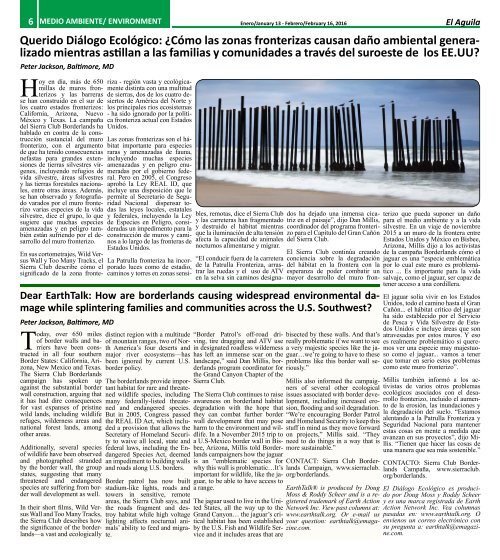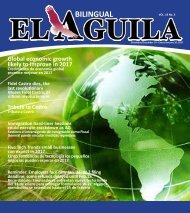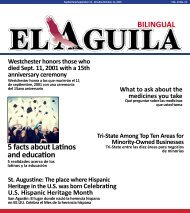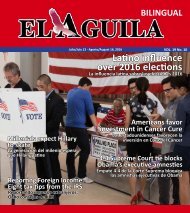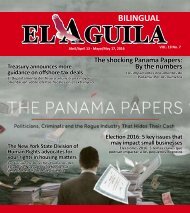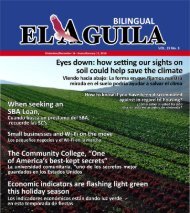El Aguila Magazine – January 13, 2016
You also want an ePaper? Increase the reach of your titles
YUMPU automatically turns print PDFs into web optimized ePapers that Google loves.
6 MEDIO AMBIENTE/ ENVIRONMENT<br />
Enero/<strong>January</strong> <strong>13</strong> - Febrero/February 16, <strong>2016</strong><br />
<strong>El</strong> <strong>Aguila</strong><br />
Querido Diálogo Ecológico: ¿Cómo las zonas fronterizas causan daño ambiental generalizado<br />
mientras astillan a las familias y comunidades a través del suroeste de los EE.UU?<br />
Peter Jackson, Baltimore, MD<br />
Hoy en día, más de 650<br />
millas de muros fronterizos<br />
y las barreras<br />
se han construido en el sur de<br />
los cuatro estados fronterizos:<br />
California, Arizona, Nuevo<br />
México y Texas. La campaña<br />
del Sierra Club Borderlands ha<br />
hablado en contra de la construcción<br />
sustancial del muro<br />
fronterizo, con el argumento<br />
de que ha tenido consecuencias<br />
nefastas para grandes extensiones<br />
de tierras silvestres vírgenes,<br />
incluyendo refugios de<br />
vida silvestre, áreas silvestres<br />
y las tierras forestales nacionales,<br />
entre otras áreas. Además,<br />
se han observado y fotografiado<br />
varados por el muro fronterizo<br />
varias especies de la vida<br />
silvestre, dice el grupo, lo que<br />
sugiere que muchas especies<br />
amenazadas y en peligro también<br />
están sufriendo por el desarrollo<br />
del muro fronterizo.<br />
Dear EarthTalk: How are borderlands causing widespread environmental damage<br />
while splintering families and communities across the U.S. Southwest?<br />
Peter Jackson, Baltimore, MD<br />
Today, over 650 miles<br />
of border walls and barriers<br />
have been constructed<br />
in all four southern<br />
Border States: California, Arizona,<br />
New Mexico and Texas.<br />
The Sierra Club Borderlands<br />
campaign has spoken up<br />
against the substantial border<br />
wall construction, arguing that<br />
it has had dire consequences<br />
for vast expanses of pristine<br />
wild lands, including wildlife<br />
refuges, wilderness areas and<br />
national forest lands, among<br />
other areas.<br />
Additionally, several species<br />
of wildlife have been observed<br />
and photographed stranded<br />
by the border wall, the group<br />
states, suggesting that many<br />
threatened and endangered<br />
species are suffering from border<br />
wall development as well.<br />
In their short films, Wild Versus<br />
Wall and Too Many Tracks,<br />
the Sierra Club describes how<br />
the significance of the borderlands—a<br />
vast and ecologically<br />
riza - región vasta y ecológicamente<br />
distinta con una multitud<br />
de sierras, dos de los cuatro desiertos<br />
de América del Norte y<br />
los principales ríos ecosistemas<br />
- ha sido ignorado por la política<br />
fronteriza actual con Estados<br />
Unidos.<br />
Las zonas fronterizas son el hábitat<br />
importante para especies<br />
raras y amenazadas de fauna,<br />
incluyendo muchas especies<br />
amenazadas y en peligro enumeradas<br />
por el gobierno federal.<br />
Pero en 2005, el Congreso<br />
aprobó la Ley REAL ID, que<br />
incluye una disposición que le<br />
permite al Secretario de Seguridad<br />
Nacional dispensar todas<br />
las leyes locales, estatales<br />
y federales, incluyendo la Ley<br />
de Especies en Peligro, consideradas<br />
un impedimento para la<br />
construcción de muros y caminos<br />
a lo largo de las fronteras de<br />
Estados Unidos.<br />
distinct region with a multitude<br />
of mountain ranges, two of North<br />
America’s four deserts and<br />
major river ecosystems—has<br />
been ignored by current U.S.<br />
border policy.<br />
The borderlands provide important<br />
habitat for rare and threatened<br />
wildlife species, including<br />
many federally-listed threatened<br />
and endangered species.<br />
But in 2005, Congress passed<br />
the REAL ID Act, which included<br />
a provision that allows the<br />
Secretary of Homeland Security<br />
to waive all local, state and<br />
federal laws, including the Endangered<br />
Species Act, deemed<br />
an impediment to building walls<br />
and roads along U.S. borders.<br />
Border patrol has now built<br />
stadium-like lights, roads and<br />
towers in sensitive, remote<br />
areas, the Sierra Club says, and<br />
the roads fragment and destroy<br />
habitat while high voltage<br />
lighting affects nocturnal animals’<br />
ability to feed and migrate.<br />
La Patrulla fronteriza ha incorporado<br />
luces como de estadio,<br />
caminos y torres en zonas sensibles,<br />
remotas, dice el Sierra Club<br />
y las carreteras han fragmentado<br />
y destruido el hábitat mientras<br />
que la iluminación de alta tensión<br />
afecta la capacidad de animales<br />
nocturnos alimentarse y migrar.<br />
“<strong>El</strong> conducir fuera de la carretera<br />
de la Patrulla Fronteriza, arrastrar<br />
las ruedas y el uso de ATV<br />
en la selva sin caminos designa-<br />
“Border Patrol’s off-road driving,<br />
tire dragging and ATV use<br />
in designated roadless wilderness<br />
has left an immense scar on the<br />
landscape,” said Dan Millis, borderlands<br />
program coordinator for<br />
the Grand Canyon Chapter of the<br />
Sierra Club.<br />
The Sierra Club continues to raise<br />
awareness on borderland habitat<br />
degradation with the hope that<br />
they can combat further border<br />
wall development that may pose<br />
harm to the environment and wildlife.<br />
In a November 2015 trip to<br />
a U.S-Mexico border wall in Bisbee,<br />
Arizona, Millis told Borderlands<br />
campaigners how the jaguar<br />
is an “emblematic species for<br />
why this wall is problematic…It’s<br />
important for wildlife, like the jaguar,<br />
to be able to have access to<br />
a range.<br />
The jaguar used to live in the United<br />
States, all the way up to the<br />
Grand Canyon… the jaguar’s critical<br />
habitat has been established<br />
by the U.S. Fish and Wildlife Service<br />
and it includes areas that are<br />
dos ha dejado una inmensa cicatriz<br />
en el paisaje”, dijo Dan Millis,<br />
coordinador del programa fronterizo<br />
para el Capítulo del Gran Cañón<br />
del Sierra Club.<br />
En sus cortometrajes, Wild Versus<br />
Wall y Too Many Tracks, el<br />
Sierra Club describe cómo el<br />
significado de la zona frontebisected<br />
by these walls. And that’s<br />
really problematic if we want to see<br />
a very majestic species like the jaguar…we’re<br />
going to have to these<br />
problems like this border wall seriously.”<br />
Millis also informed the campaigners<br />
of several other ecological<br />
issues associated with border development,<br />
including increased erosion,<br />
flooding and soil degradation.<br />
“We’re encouraging Border Patrol<br />
and Homeland Security to keep this<br />
stuff in mind as they move forward<br />
on projects,” Millis said. “They<br />
need to do things in a way that is<br />
more sustainable.”<br />
CONTACT: Sierra Club Borderlands<br />
Campaign, www.sierraclub.<br />
org/borderlands.<br />
EarthTalk® is produced by Doug<br />
Moss & Roddy Scheer and is a registered<br />
trademark of Earth Action<br />
Network Inc. View past columns at:<br />
www.earthtalk.org. Or e-mail us<br />
your question: earthtalk@emagazine.com.<br />
<strong>El</strong> Sierra Club continúa creando<br />
conciencia sobre la degradación<br />
del hábitat en la frontera con la<br />
esperanza de poder combatir un<br />
mayor desarrollo del muro fronterizo<br />
que pueda suponer un daño<br />
para el medio ambiente y a la vida<br />
silvestre. En un viaje de noviembre<br />
2015 a un muro de la frontera entre<br />
Estados Unidos y México en Bisbee,<br />
Arizona, Millis dijo a los activistas<br />
de la campaña Borderlands cómo el<br />
jaguar es una “especie emblemática<br />
por lo cual este muro es problemático<br />
... Es importante para la vida<br />
salvaje, como el jaguar, ser capaz de<br />
tener acceso a una cordillera.<br />
<strong>El</strong> jaguar solía vivir en los Estados<br />
Unidos, todo el camino hasta el Gran<br />
Cañón... el hábitat crítico del jaguar<br />
ha sido establecido por el Servicio<br />
de Pesca y Vida Silvestre de Estados<br />
Unidos e incluye áreas que son<br />
atravesadas por estos muros. Y eso<br />
es realmente problemático si queremos<br />
ver una especie muy majestuoso<br />
como el jaguar... vamos a tener<br />
que tomar en serio estos problemas<br />
como este muro fronterizo”.<br />
Millis también informó a los activistas<br />
de varios otros problemas<br />
ecológicos asociados con el desarrollo<br />
fronterizo, incluido el aumento<br />
de la erosión, las inundaciones y<br />
la degradación del suelo. “Estamos<br />
alentando a la Patrulla Fronteriza y<br />
Seguridad Nacional para mantener<br />
estas cosas en mente a medida que<br />
avanzan en sus proyectos”, dijo Millis.<br />
“Tienen que hacer las cosas de<br />
una manera que sea más sostenible.”<br />
CONTACTO: Sierra Club Borderlands<br />
Campaña, www.sierraclub.<br />
org/borderlands.<br />
<strong>El</strong> Diálogo Ecológico es producido<br />
por Doug Moss y Roddy Scheer<br />
y es una marca registrada de Earth<br />
Action Network Inc. Vea columnas<br />
pasadas en: www.earthtalk.org. O<br />
envíenos un correo electrónico con<br />
su pregunta a: earthtalk@emagazine.com.


